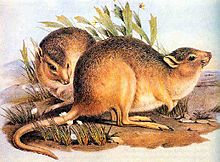- Desert Rat-kangaroo
-
Desert Rat-kangaroo 
Conservation status Scientific classification Kingdom: Animalia Phylum: Chordata Class: Mammalia Infraclass: Marsupialia Order: Diprotodontia Family: Potoroidae Genus: †Caloprymnus
Thomas, 1888Species: †C. campestris Binomial name Caloprymnus campestris
(Gould, 1843)The Desert Rat-kangaroo (Caloprymnus campestris), also called the Buff-nosed Rat-kangaroo or the Plains Rat-kangaroo, is an extinct marsupial that lived in a sand ridge and gibber plain habitat in southwestern Queensland and northeastern South Australia.[2] It was the size of a small rabbit. It showed great endurance while being chased on horseback at high speeds, and "paused only to die".[3] It sheltered in a flimsy nest by day. At night, it emerged to feed. It lived alone and was so independent of water that it even shunned the succulent plants of the sand hills. It was first recorded by Europeans around 1841 and was not seen again for 90 years.
Contents
Discovery
The Desert Rat-Kangaroo was discovered in the early 1840's and described by John Gould in London in 1843, on the basis of three specimens sent to him by George Grey, the governor of South Australia at the time.[4][5] However, after these early sightings, it was no longer recorded (aside from an unconfirmed report in 1878), and was widely believed to be extinct.[5]
Rediscovery
Following the relief of drought conditions which improved the local habitat, the animal was rediscovered in 1931 when Hedley Finlayson found a thriving colony of them.[4][5] He made multiple returns, but after a few years the population disappeared. The last confirmed record of the species came in 1935 from near Ooroowilanie, east of Lake Eyre.[2] There have been subsequent reported sightings of the animal in Queensland following periods of rain in the 1950's and again in the 1970's;[1][4] possibly recent remains of the animal were also found during this period.[6]
Extinction
The Desert Rat-kangaroo was declared extinct in 1994,[1] making it the only mammal species to be recovered and then lost again.[7] The rapid decline of the Desert Rat-kangaroo shortly after its recovery in 1931 correlates with the invasion of its habitat by the red fox.[7] In view of its amazing recovery following a ninety year period when it wasn't seen, the extinction of the Desert Rat-kangaroo is not certain; thus, sightings of this animal would not fall into the cryptozoology category.
In similar cases, the Broad-faced Potoroo was last seen in the late 19th century and is considered extinct, Gilbert's Potoroo was considered extinct for 120 years prior to its rediscovery in 1994, while the Long-footed Potoroo was only discovered in 1967.
References
- ^ a b c Australasian Mammal Assessment Workshop (2008). Caloprymnus campestris. In: IUCN 2008. IUCN Red List of Threatened Species. Downloaded on 29 December 2008. Database entry includes justification for why this species is listed as extinct
- ^ a b "Caloprymnus campestris — Desert Rat-kangaroo". Australian Department of Sustainability, Environment, Water, Population and Communities. http://www.environment.gov.au/cgi-bin/sprat/public/publicspecies.pl?taxon_id=215. Retrieved 2011-09-03.
- ^ Heddle, Enid Moodie; Millington, Iris (1962), How Australian literature grew, F. W. Cheshire, http://books.google.com/?id=VhnVAAAAMAAJ&dq=%22paused+only+to+die%22+kangaroo&q=%22paused+only+to+die%22+#search_anchor, retrieved 01-08-2009
- ^ a b c Johnson, C. (2006). "Chapter 1: A brief history of Australia’s mammals". Australia's mammal extinctions: a 50,000 year history. Cambridge University Press. pp. 278. ISBN 978-0521849180. OCLC 63187432. http://assets.cambridge.org/97805218/49180/excerpt/9780521849180_excerpt.pdf.
- ^ a b c Finlayson, H. H. (1932-06-11). "Rediscovery of Caloprymnus campestris (Marsupialia)". Nature 129: 871–871. doi:10.1038/129871b0. http://www.nature.com/nature/journal/v129/n3267/abs/129871b0.html. Retrieved 2011-09-03.
- ^ DuVall, L. (1999). "Caloprymnus campestris". Animal Diversity Web. University of Michigan Museum of Zoology. http://animaldiversity.ummz.umich.edu/site/accounts/information/Caloprymnus_campestris.html. Retrieved 2011-09-03.
- ^ a b Fisher, D. O.; Blomberg, S. P. (2010-09-29). "Correlates of rediscovery and the detectability of extinction in mammals". Proceedings of the Royal Society B 278 (1708): 1090–1097. doi:10.1098/rspb.2010.1579. PMID 20880890. http://rspb.royalsocietypublishing.org/content/278/1708/1090.abstract. Retrieved 2011-09-03.
Categories:- IUCN Red List extinct species
- Extinct mammals of Australia
- Extinct mammals of South Australia
- Extinct marsupials
- Potoroids
- Mammal extinctions since 1500
Wikimedia Foundation. 2010.

